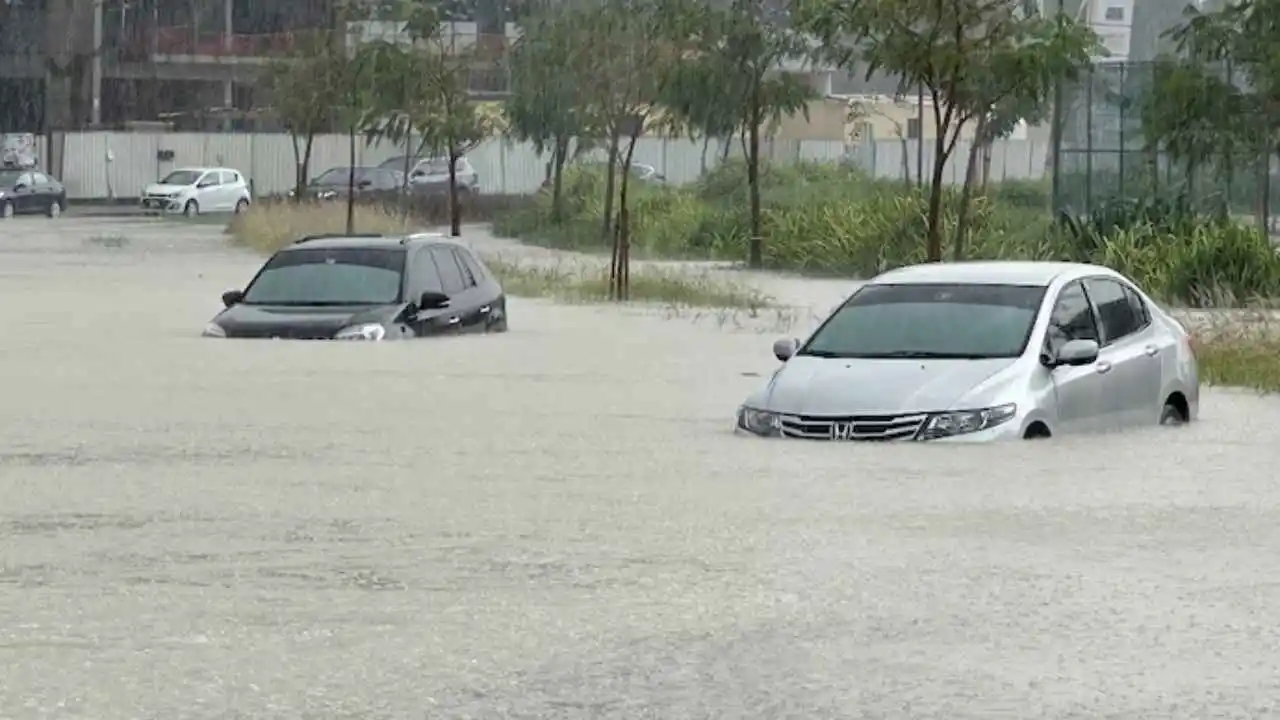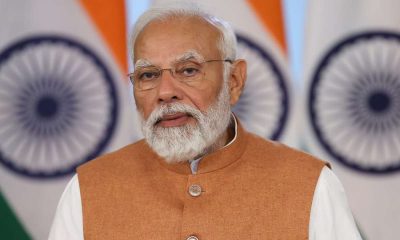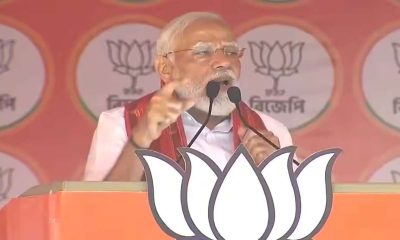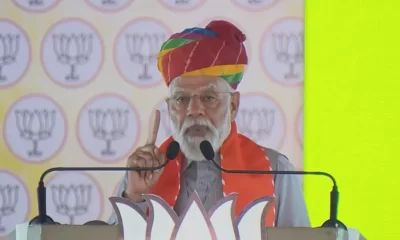Latest world news
US-China trade war: Trump imposes third wave of tariffs on $200bn of Chinese goods

[vc_row][vc_column][vc_column_text]The escalating US-China trade war entered a new phase with US President Donald Trump on Monday announcing new tariffs on an additional USD 200 billion worth of imports from China.
These will apply to almost 6,000 items, marking the biggest round of US tariffs so far. With Monday’s announcement, roughly half of the $505 billion in goods that Americans buy annually from Chinese firms will face new import levies and consumers will have to shell out more for these goods.
Starting Sept 24, American importers will pay an extra 10 percent tariff for the affected items, rising to 25 percent at the end of the year, according to senior administration officials, who briefed reporters.
Trump, accusing China of refusing to change its unfair trade practices, said the new additional tariff structure would be effective September 24 from when it would be at 10 percent until the year end, but would increase to 25 per cent level from January 1.
This latest round marks the third set of tariffs put into motion so far this year. In July, the White House increased charges on $34bn worth of Chinese products. Then last month, the escalating trade war moved up a gear when the US brought in a 25% tax on a second wave of goods worth $16bn.
After the latest round, around half of all Chinese imports to the US are now subject to the new duties. It is also the biggest set of tariffs to date, and unlike the earlier rounds this latest list targets consumer goods, such as luggage and furniture.
That means regular households may start to feel the impact from higher prices. US companies have already said they are worried about the effect of higher costs on their businesses and warned of the risk of job cuts.
Unlike the $50 billion in Chinese products that Trump hit in the first tariff wave in July, which fell mainly on industrial goods, Monday’s action will affect consumer products such as air conditioners, spark plugs, furniture and lamps.
Officials have said they want to shield consumer goods from the taxes as much as possible.
But Monday’s action will affect consumer products such as air conditioners, spark plugs, furniture and many everyday items such as suitcases, handbags, toilet paper and wool. The list also includes several food items from frozen cuts of meat, to almost all types of fish from smoked mackerel to scallops and soybeans, various types of fruit and cereal and rice.
Products that help computer networks operate, such as routers, are also targeted.
The list slated for tariffs originally included more than 6,000 items, but US officials later removed about 300 types of items, including smart watches, bicycle helmets, play pens, high chairs and baby car seats.
The changes come after fierce opposition from companies, including global tech giants such as Apple, Dell and Hewlett Packard Enterprise. The US trade representative’s office received roughly 6,000 written comments when Trump first proposed the new tariffs, most opposing them.
The firms complained the tariffs would make their products more expensive, since many of their products are manufactured in China, costing them sales.
So far, however, the US economy has shrugged off the president’s trade war. While individual companies have complained about their operations being disrupted by material shortages or cost increases, growth remains strong and unemployment is approaching a half-century low.
Excluding fuel, import prices rose just 1.3 percent over the past year, according to the Bureau of Labor Statistics.
But uncertainty over trade policy remains unusually high. While economists generally estimate that the tariffs will have little impact on the overall US economy, they have warned that the effects are difficult to predict.[/vc_column_text][vc_column_text css=”.vc_custom_1537264144661{padding-top: 10px !important;padding-right: 10px !important;padding-bottom: 10px !important;padding-left: 10px !important;background-color: #a2b1bf !important;border-radius: 10px !important;}”]Trump has long been fiercely critical of China, accusing it during the 2016 campaign of “the rape” of the American economy and vowing to create a more balanced trade pattern. Yet despite months of tariff talk, the gap between what the US buys from China and what it sells there continues to widen.
Through July, the US ran a $233.5 billion trade deficit in goods trade with China, an 8 percent increase compared with the same period in 2017.[/vc_column_text][vc_column_text]
China has vowed to retaliate for the latest US tariffs with new import taxes on $60 billion in American products. If that happens, the president said, he would immediately begin the process of approving tariffs on a further $267 billion in Chinese imports – effectively taxing everything Americans buy from China.
“… if China takes retaliatory action against our farmers or other industries, we will immediately pursue phase three, which is tariffs on approximately USD 267 billion of additional imports,” Trump said in a strong warning to China.
The US action came even as Chinese officials weighed an invitation to visit Washington for new talks aimed at ending the months-old dispute. “The Trump administration is yet again sending a perplexing mixed message by inviting Chinese officials for negotiations and then imposing additional tariffs in the run-up to the talks,” said media reports quoting Eswar Prasad, former head of the International Monetary Fund’s China division. “It is difficult to see what the administration’s vision of an end game might be other than total capitulation by China to all US demands.”
Trump said his administration is taking this action as a result of the Section 301 process that the USTR has been pursuing for more than 12 months. US Trade Representatives (USTR) released a list of such items.
After a thorough study, the USTR concluded that China is engaged in numerous unfair policies and practices relating to US technology and intellectual property – such as forcing United States companies to transfer technology to Chinese counterparts, he said.
These practices plainly constitute a grave threat to the long-term health and prosperity of the US economy, he added.
“For months, we have urged China to change these unfair practices, and give fair and reciprocal treatment to American companies. We have been very clear about the type of changes that need to be made, and we have given China every opportunity to treat us more fairly,” he said.
“But, so far, China has been unwilling to change its practices,” he said. To counter China’s unfair practices, he had announced on June 15 that the US would impose tariffs of 25 percent on USD 50 billion worth of Chinese imports.
“China, however, still refuses to change its practices – and indeed recently imposed new tariffs in an effort to hurt the United States economy,” Trump said.
China, he said, has had many opportunities to fully address US concerns. “I urge China’s leaders to take swift action to end their country’s unfair trade practices. Hopefully, this trade situation will be resolved, in the end, by myself and President Xi of China, for whom I have great respect and affection,” Trump said.
Later a senior administration official told reporters that China has had many opportunities to change those practices and, in fact, the statute says that trade representatives shall take all appropriate and feasible action in an effort to obtain the elimination of those practices.
“So we’ve negotiated and negotiated and negotiated and given them chance after chance after chance… The administration has imposed tariffs on roughly USD 50 billion worth of Chinese imports already, in an effort to encourage China to alter its behaviour,” the official said.
By imposing such a tariff, the official said, the US is not trying to constrain China’s growth.
“We have no problem with China trying to grow its economy, trying to lift its people out of poverty, that’s a good thing. But, in doing so, they can’t take actions that deliberately discriminate against other countries; actions that hurt American workers. And they can’t take actions that entirely flout the rules of the international trading system,” the official said.
“This is an effort to work with China and say, it’s time that you address these unfair trading practices that we have identified, that others have identified, and which have harmed the entire global trading system,” the official asserted.
At the same time, the official said, the US remains open to negotiations. “We don’t have anything to announce to you today, in terms of any of the logistics of that, but, as the President has said, we are open to that and we hope that China will come to the table and address the concerns that we have raised,” the official said.
House Ways and Means Committee Chairman Kevin Brady said Trump is clearly increasing the pressure on China to come to the table and begin a new trading relationship that is fairer to the American farmers, workers and businesses.
“The sooner President Xi and President Donald Trump meet to craft a new trade path forward, the better,” he said.
“There is no disagreement between the Congress and the President that we must hold China accountable for hurting the US companies and workers on a colossal scale by extorting our companies to transfer their best technology, stealing our intellectual property, and shoring up China’s state-run companies through subsidies and other distortive practices,” Brady said.
“Any time tariffs are imposed, I worry that Americans will be forced to pay extra costs – in this case on nearly half of the US imports from China,” he said.[/vc_column_text][/vc_column][/vc_row]
Latest world news
World Earth Day 2024: Google Doodle showcases aerial view of planet’s natural beauty
Google celebrated Earth Day 2024 with a special doodle featuring an aerial view of our planet’s biodiversity.

Google shared a doodle today to celebrate World Earth Day 2024, which showcased aerial photos of the planet’s biodiversity and natural beauty. Google reminded us of the importance of protecting planet earth for future generations with the help of this doodle.
The Google letters depict specific locations across the globe where people, communities, and governments work every day to help protect the planet’s natural beauty, biodiversity, and resources, according to the explanation of the annual Earth Day 2024 doodle on their website.
It said, these examples remind us that there’s much more to do to address the climate crisis and biodiversity loss, but also offer the promise of hope and optimism.
The islands of Turks and Caicos are represented by the letter “G.” The islands’ conservation efforts are concentrated on protecting important regions for biodiversity and addressing persistent environmental problems.
The largest reef in the southern Gulf of Mexico and a UNESCO biosphere reserve, Scorpion Reef National Park, is represented by the letter “O” in the Mexican flag.
The letter “O” features Iceland’s Vatnajokull National Park, which was designated as a national park in 2008 following decades of advocacy. The ecology within and surrounding the biggest glacier in Europe is safeguarded by this UNESCO World Heritage Site.
The letter “G” has the Jau National Park in Brazil on it. It is a UNESCO World Heritage Site and one of the biggest forest reserves in South America.
The Great Green Wall of Nigeria is represented by the letter “L,” and the Pilbara Islands Nature Reserves of Australia are represented by the letter “E.”
Meanwhile, Earth Day is a worldwide event that promotes protection of the environment every year. April 22 serves as a reminder of the importance of conservation efforts and sustainable practices to guarantee a healthier world and a brighter future.
The occasion inspires people across the world to come together and take action to protect the environment, strengthening our bonds with nature and promoting good change.
Latest world news
Bigg Boss 14 contestant Rahul Vaidya struggles walking in knee deep water, compares Dubai rains with Mumbai floods
Singer and TV personality Rahul Vaidya was recently stranded in the Dubai rains.

Rahul Vaidya, who was in Dubai ahead of his show which was scheduled to take place today, left the country due to heavy rains and reached Kolkata. The artist shared on social media his encounters in the UAE city, including challenges like walking through knee-deep water. Rahul provided an update regarding the heavy rainfall in Dubai on his Instagram profile.
The Bigg Boss 14 contestant revealed that he was in Kolkata and prepared to do an evening performance. Recalling the terrifying period he went through, Vaidya said there was a lot of confusion and panic in Dubai. The situation was similar to that when heavy floods hit Mumbai in 2005.
Vaiday also posted seval other images and videos of cars that were underwater and flooded roadways. The Bigg Boss 14 contestant, who shared his ordeal, claimed that even though it had just rained for two hours, the situation was dire.
In one of the video, which went viral he can be seen struggling in walking in knee-deep water. He can be also seen holding his sneakers in one hand and with other hand he was seen managing other things.
This is the result of the two hours of rain that it had, he can be heard saying in the video. Vidya also said he dosen’t believe Dubai is accustomed to a lot of rain. Everything had stopped working, he remarked.
After taking part in the first season of the singing reality show Indian Idol, Rahul Vaidya gained widespread recognition. In addition to Bigg Boss, he took part in Khatron Ke Khiladi 11.
Meanwhile, heavy rains that triggered flooding in the UAE and Bahrain, which left 18 people dead in Oman on Sunday and Monday, have paralyzed the financial hub of the Middle East, Dubai.
A lot of incoming flights were diverted from Dubai’s international airport because of the rain. At 7:26 p.m., the busiest airport in the world for foreign visitors stopped accepting new arrivals; a gradual resumption was announced for more than two hours later.
Images of planes navigating flooded tarmacs are making the rounds on social media.
According to pictures shared on social media, the flagship malls Dubai Mall and Mall of the Emirates both experienced heavy floods, while at least one Dubai Metro station had water up to the ankles.
There were several road collapses, severe flooding in residential areas, and numerous reports of leaks from windows, doors, and roofs.
Due to the unfavourable weather, schools around the United Arab Emirates were forced to close, and as more storms are predicted, the closures are anticipated to last until Wednesday. The government of Dubai allowed its staff to work remotely till this Wednesday.
Latest world news
Dubai sky turns green during storm in UAE, video goes viral
The UAE witnessed record-breaking rainfall on Tuesday and the National Centre of Meteorology recorded 254 mm of rainfall in less than 24 hrs in the Khatm Al Shakla area in Al Ain.

1 person was killed in UAE as it witnessed heavy rainfall on Tuesday, stranding commuters, flooding roads, disrupting trains and flights and resulting in water leakage from mall ceilings. The UAE witnessed record-breaking rainfall on Tuesday and the National Centre of Meteorology recorded 254 mm of rainfall in less than 24 hrs in the Khatm Al Shakla area in Al Ain. It is being said that the rainfall was the highest documented since the start of data collection in 1949.
The heavy rainfall in UAE came days after a similar situation in neighbouring Oman, where 13 people were killed in flash floods. Many parts of Oman saw torrential rains, which caused students to be trapped in buses and swept away motorists and trapped people in their homes.
Videos from Dubai circulating on social media showed widespread waterlogging on roads in Abu Dhabi, Dubai and other important cities. This left daily commuters in cars and other vehicles struggling to get back home. Dubai metro station too was seen flooded and closed.
One such video circulating on social media shows the aerial view of the city of Dubai from the top of a building. In the video the stormy winds are seen blowing over the city of Dubai. As the storm intensifies the Dubai sky turns green and ultimately gets covered by heavy rainfall. The video has gone viral on social media with more than 1.1 million views.
Another video showed water leakage from the ceilings of shopping malls, flooding the floors and destroying goods. A video which was shot in the famous Mall of the Emirates, showed pieces of ceiling falling as the rainwater gushed inside. Videos from many outlets of the Deira City Centre mall chain showed escalators being rendered unusable. Majid Al Futtaim, the company which owns the Mall of Emirates, said that the shopping complexes have been kept open and the customers are being sent away from the flooded areas.
-

 2024 Lok Sabha Elections19 hours ago
2024 Lok Sabha Elections19 hours agoPM Modi calls for high voter turnout in second phase of Lok Sabha elections 2024, says your vote is your voice
-

 2024 Lok Sabha Elections13 hours ago
2024 Lok Sabha Elections13 hours agoLok Sabha election 2024: Nearly 50% voter turnout recorded in second phase till 3 pm
-

 India News18 hours ago
India News18 hours agoSalman Khan house firing case: NIA interrogates arrested shooters Sagar Pal, Vicky Gupta for three hours
-

 2024 Lok Sabha Elections12 hours ago
2024 Lok Sabha Elections12 hours agoElection Commission books BJP MP Tejasvi Surya for seeking votes in the name of religion
-

 2024 Lok Sabha Elections16 hours ago
2024 Lok Sabha Elections16 hours agoLok Sabha elections 2024: 102-year-old man walks to polling booth to cast his vote in Jammu













